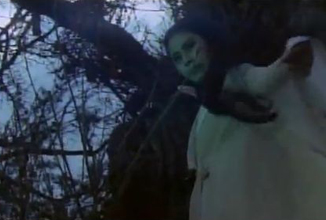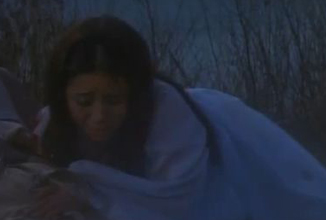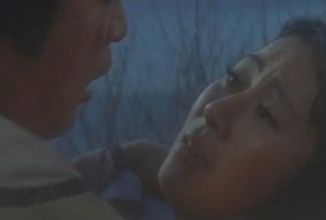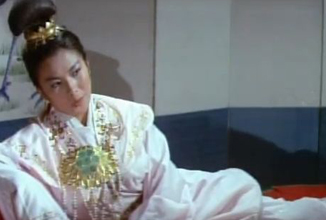 |
Synopsis:
In the Three Kingdoms Period of ancient Korea, the Silla queen Jin-seong (Kim Hye-jeong) attempts to seduce nobleman Wong-rang (Shin Young-kyun). Tempted though he may be, Wong-rang rejects her advances out of faithfulness to his wife Yeo-hwa (Kim Ji-su) and, utterly enraged at his audacity, the queen immediately banishes both Wong-rang and Yeo-hwa from the kingdom.
Before long while trekking through the mountains, Yeo-hwa is set upon by bandits and in the process of her desperate efforts to escape she falls into a lake; seemingly drowning.
However, held captive in the lake is the spirit of a fox demon who possesses Yeo-hwa’s body to exact vengeance on those who killed her baby and imprisoned her in the watery depths…
Review:
In any culture you care to mention, mythological tales and historical 'other-worldly' legends detail heroes' struggles against adversity for both their own and the greater good; moral guidance being inherent to each and every one.
As such, even a cursory glance reveals numerous cautionary references to the danger of succumbing to baser human instincts with an almost endless procession of 'femme fatale' figures - from the Sirens of ancient Greece to the succubi of Mediaeval Europe etc. etc. - intent on dragging man to his doom through the promise of love and sex.
To my mind, one of the most evocative of these legends is that of the Korean gumiho - a fox demon often masquerading as a beautiful woman who in its thousandth year sets about stealing the essence of a chosen male (usually by means of a magical marble during intercourse); subsequently killing its 'prey' and eating the victim's liver in order to become permanently human - though, as is the case with so many cinematic interpretations of mythological stories, tales of the gumiho in Korean films over the years have somewhat morphed to serve the specific genre elements required; be they horror, thriller, romance or even comedy, at the same time as being made to ensure the prevailing undertones of melodrama within Korean films are maintained.
However, the narrative of Thousand Years Old Fox takes a far more classic and indeed 'classic horror' tack in its depiction of the disembodied spirit of a gumiho taking possession of a human body in order to exact revenge, and, as such, the film stands as a bridge, in a way, between the standard ghost/evil spirit horror tales, so prevalent in Asian cinema over the years, and the gumiho horror-romances that would eventually follow.
Not only that, but in terms of both the horror elements themselves and the visual realisation of the film's action sequences, Thousand Years Old Fox could almost be seen as a template for those later films and television series; with a number of visual and wirework sequences in some later productions (for example, film ‘The Fox with Nine Tails’ or TV shows ‘Fox Child’ and even, to a degree,‘My Girlfriend is a Gumiho’) feeling eerily familiar, if you will, to the extent that Thousand Years Old Fox being used as the standard against which others have set their sights would very much appear to have been the rule throughout the years, rather than the exception.
 |
 |
Though the fact that the decision to focus the plot on the idea of a disembodied, vengeful spirit wreaking havoc through possession of an innocent negates any real need for unwieldy character prosthetics - Thousand Years Old Fox was, of course, years prior to the invention/introduction of computer generated graphics - director Shin Sang-ok nevertheless chooses to give his demonic character a certain amount of ‘fox’ make-up but, that said, there is thankfully still a reliance on actress Kim Ji-su separating human from fox demon through her performance; thereby strengthening the film’s narrative believability yet further.
As already stated, in the forty-plus years since Thousand Years Old Fox was made, to virtually the present day, gumiho mythology has formed the basis of and been referenced in a number of films and television shows, but where the majority differ most from Thousand Years Old Fox is in their underlying themes:
In virtually every other instance, the question of what it is to be human and what constitutes humanity itself lies at the very core of narratives. As the gumiho in each of these cases gets closer to achieving permanent humanity, the less humane its increasingly violent actions must become - thereby destroying the very humanity it seeks - leading to the eventual implication that not only can humanity not be physically sought but also that in order to become truly human the gumiho must ultimately sacrifice its quest, and indeed itself. Of course, these narrative ideas open the door for almost obligatory, and still prevalent, Korean melodrama elements to be brought into play but while Thousand Years Old Fox’s somewhat simpler tale seems to stand out in hindsight as almost an exception in having no such themes present, it was the forerunner and in a way the original. Simpler in narrative style it may be, but Thousand Years Old Fox nonetheless deftly concludes (as do all of the above) as the melodrama it rightly needs to be, in classic Korean cinema style.
 |
 |
Of course, being a Korean film from the 1960s, the acting in Thousand Years Old Fox is far more demonstrative than the nuanced performances of the present day but that, in fact, adds greatly to the charm of the film and as is the case with the majority of films from the Golden Age of Korean Cinema gives an almost theatrical feeling throughout.
Finally, no discussion of a film directed by Shin Sang-ok would be complete without an obligatory mention of the events that placed his name in newspaper headlines for years on end:
In 1978, after having divorced Shim Sang-ok, actress Choi Eun-hee travelled to Hong Kong where she was abducted by North Korean operatives on the orders of cinema-obsessed North Korean leader Kim Jong-il. On going to Hong Kong himself to try to ascertain what had befallen his ex-wife, Shin Sang-ok was abducted too and was held in North Korea for a number of years to make films for the North Korean market; in the process remarrying Choi Eun-hee - according to many, at Kim Jong-il’s insistence.
Both Shin Sang-ok and Choi Eun-hee eventually escaped from North Korea in 1986 while attending a film festival in Vienna, but the question of whether he and his ex-wife were really abducted or in fact went to North Korea voluntarily somewhat dogged Shin Sang-ok throughout his subsequent career (making films in the US under the name Simon Sheen in the 90s) until his death in 2006.
Regardless of which side of the fence you sit in relation to the story and allegations, there is no denying Shin Sang-ok’s importance to Korean cinema as a film-maker but though it could be said that this twisted true-life tale has repeatedly brought even more of a focus to his work, the sad fact remains that his films and talent will, at the very least, likely always be suffixed by claims of abduction or collusion, and at the worst be rather overshadowed by them.
Cast: Shin Young-kyun, Kim Ji-su, Kim Hye-jeong
Director:
Shin Sang-ok
Duration: 89mins (approx.)
'Thousand Years Old Fox' is currently available to view for free on the Korean Film Archive's YouTube channel at:
http://www.youtube.com/verify_age?next_url=/watch%3Fv%3Dal89UmscEPs%26playnext%3D1%26list%3DPL787B4B9F8A07125E
Viewers should be aware that they will need to subscribe (again free) to the KOFA YouTube channel before being able to watch the film.
Please note that prospective viewers of 'Thousand Years Old Fox must be 18 or over.
Summary:
‘Thousand Years Old Fox’ takes a classic and indeed 'classic horror' tack in its depiction of the disembodied spirit of a gumiho taking possession of a human body to exact revenge and, as such, the film stands almost as a bridge between the standard ghost/evil spirit horror tales so prevalent in Asian cinema over the years and the gumiho horror-romances that would eventually follow. Demonstrative and theatrical throughout, ‘Thousand Years Old Fox’ is ultimately as important as it is enjoyable.
|
All images © Korean Film Archive, Korean Film Council.
Review © Paul Quinn
|
| |
|







